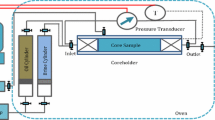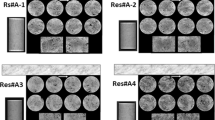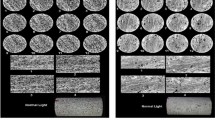Abstract
Injection of smart water into reservoirs for recovery enhancements remains a low-cost and an environmentally safe method of enhanced oil recovery (EOR). However, a definitive explanation for the incremental recovery enhancement, or lack thereof, is far from established and the research, therefore, continues to be very active. This study investigates the effect of divalent ion-based modified brines on wettability alteration in carbonate reservoirs. The focus is on analyzing wettability alteration via integrating precise quantitative zeta potential measurements and contact angle analysis. Experiments were carried out on carbonate core-plug samples analyzing the impact of various brines, including formation brine, seawater, low salinity, and engineered smart water. Specific formulations were prepared using softened seawater with multiple dilution factors and optimized phosphate and hexametaphosphate concentrations. To establish the baseline wetting state, core-plug samples were aged with the respective light crude oil and formation brine from a giant Abu Dhabi carbonate oilfield. Wettability alteration confirmed by changes in contact angles was recorded over a span of 72–80 h with each of the tested brines. Zeta potential measurements were performed utilizing a reproducible approach on the same core-plug samples at all stages of the experiments. The integrated measurements presented important conclusions on the effect of ionically modified smart brines on wettability alteration.













Similar content being viewed by others
References
Tang, G.Q.; Morrow, N.R.: Salinity, temperature, oil composition, and oil recovery by waterflooding. SPE Reserv. Eng. 12(04), 269–276 (1997). https://doi.org/10.2118/36680-PA
Seccombe, J.; Lager, A.; Jerauld, G.; Jhaveri, B. et al.: Demonstration of low-salinity eor at interwell scale, endicott field, Alaska. In: SPE Improved Oil Recovery Symposium, (2010). doi: https://doi.org/10.2118/129692-MS
Vledder,P.; Fonseca, J.C.; Wells, T.; Gonzalez I.; Ligthelm, D.: Low salinity water flooding: proof of wettability alteration on a field wide scale. In: SPE Improved Oil Recovery Symposium, (2010). doi: https://doi.org/10.2118/129564-MS
Yousef, A.A.; Liu, J.; Blanchard, G.; Al-Saleh, S.: Smartwater flooding: industry’s first field test in carbonate reservoirs. In: SPE Annual Technical Conference and Exhibition, (2012). doi: https://doi.org/10.2118/159526-MS
Yim, Y.; Haroun, M.R.; Al Kobaisi, M.; Sarma, H.K.; Gomes, J.S.; Rahman, M.: Experimental investigation of electrokinetic assisted hybrid smartwater EOR in carbonate reservoirs. In: SPE Abu Dhabi International Petroleum Exhibition and Conference, (2017). doi: https://doi.org/10.2118/188267-MS
Meng, W.; Haroun, M.R.; Sarma, H.K., Adeoye; J.T., Aras, P.; Punjabi, S.; Rahman, M.M.; Al Kobaisi, M.: A novel approach of using phosphate-spiked Smart brines to alter wettability in mixed oil-wet carbonate reservoirs. In: SPEAbu Dhabi International Petroleum Exhibition and Conference, (2015). doi: https://doi.org/10.2118/177551-MS
Hao, J.; Mohammadkhani, S.; Shahverdi, H.; Esfahany, M.N.; Shapiro, A.: Mechanisms of smart waterflooding in carbonate oil reservoirs–a review. J. Pet. Sci. Eng. 179, 276–291 (2019). https://doi.org/10.1016/j.petrol.2019.04.049
Maghsoudian, A.; Esfandiarian, A.; Kord, S.; Tamsilian, Y.; Soulgani, B.S.: Direct insights into the micro and macro scale mechanisms of symbiotic effect of SO42−, Mg2+, and Ca2+ ions concentration for smart waterflooding in the carbonated coated micromodel system. J. Mol. Liq. 315, 113700 (2020). https://doi.org/10.1016/j.molliq.2020.113700
Sadeed, A.; Tariq, Z.; Janjua, A.N.; Asad, A.; Hossain, M.E.: Smart water flooding: an economic evaluation and optimization. In: Presented at the SPE Kingdom of Saudi Arabia Annual Technical Symposium and Exhibition, (2018). doi: https://doi.org/10.2118/192330-MS
Ding, H.; Wang, Y.; Shapoval, A.; Zhao, Y.; Rahman, S.: Macro- and microscopic studies of ‘smart water’ flooding in carbonate rocks: an image-based wettability examination. Energy Fuels 33, 6961–6970 (2019). https://doi.org/10.1021/acs.energyfuels.9b00638
Mofrad, S.K.; Dehaghani, A.H.S.: An experimental investigation into enhancing oil recovery using smart water combined with anionic and cationic surfactants in carbonate reservoir. Energy Rep. 6, 543–549 (2020). https://doi.org/10.1016/j.egyr.2020.02.034
Ghosh, B.; Al-Hamairi, A.; **, S.: Carbonated water injection: an efficient EOR approach. A review of fundamentals and prospects. J. Explor. Prod. Technol. 10, 673–685 (2020). https://doi.org/10.1007/s13202-019-0738-2
Buckley, J.S.; Liu, Y.; Monsterleet, S.: Mechanisms of wetting alteration by crude oils. SPE J. 3(01), 54–61 (1998). https://doi.org/10.2118/37230-PA
McGuire,P.L.; Chatham, J.R.; Paskvan, F.K.; Sommer, D.M.; Carini, F.H.: Low salinity oil recovery: an exciting new EOR opportunity for Alaska’s North Slope. In: SPE Western Regional Meeting, (2005). doi: https://doi.org/10.2118/93903-MS
Tang, G.-Q.; Morrow, N.R.: Influence of brine composition and fines migration on crude oil/brine/rock interactions and oil recovery. J. Pet. Sci. Eng. 24(2), 99–111 (1999). https://doi.org/10.1016/S0920-4105(99)00034-0
Austad,T.; RezaeiDoust, A.; Puntervold, T.: Chemical mechanism of low salinity water flooding in sandstone reservoirs. In: SPE Improved Oil Recovery Symposium, (2010). doi: https://doi.org/10.2118/129767-MS
Lager, A.K.; Webb, J.; Black, C.J.J.; Singleton, M.; Sorbie, K.S.: Low salinity oil recovery–an experimental investigation. Petrophys. SPWLA J. Form. Eval. Reserv. Descr. 49(01), 1–5 (2008)
Nasralla, R.A.; Nasr-El-Din, H.A.: Double-layer expansion: is it a primary mechanism of improved oil recovery by low-salinity waterflooding? SPE Reserv. Eval. Eng. 17(01), 49–59 (2014). https://doi.org/10.2118/154334-PA
Kilybay, A.; Ghosh, B.; Thomas, N.C.; Sulemana, N.T.: Hybrid EOR technology: carbonated water-smart water flood improved recovery in oil wet carbonate formation: Part-II. In: SPE 185321, SPE Oil and gas India Conference and Exhibition, Mumbai, (2017)
Nasralla, R.A.; Bataweel, M.A.; Nasr-El-Din, H.A.: Investigation of wettability alteration and oil-recovery improvement by low-salinity water in sandstone rock. J. Can. Pet. Technol. 52(02), 144–154 (2013). https://doi.org/10.2118/146322-PA
Ligthelm,D.J.; Gronsveld, J.; Hofman, J.P.; Brussee, N.J.; Marcelis, F.; van der Linde, H.A.: Novel waterflooding strategy by manipulation of injection brine composition. In: EUROPEC/EAGE Conference and Exhibition, (2009). doi: https://doi.org/10.2118/119835-MS
Morrow, N.; Buckley, J.: Improved oil recovery by low-salinity waterflooding. J. Pet. Technol. 63(05), 106–112 (2011). https://doi.org/10.2118/129421-JPT
Rahman, M.M.; Haroun, M.; Al Kobaisi, M.; Kim, M.; Suboyin, A.; Somra, B.; Ponnambathayil, J.A.; Punjabi, S.: Insights into nanoparticles, electrokinetics and hybrid techniques on improving oil recovered in carbonate reservoirs. Energies 15, 5502 (2022). https://doi.org/10.3390/en15155502
Uzun,O.; Kazemi, H.; Sonnenberg, S.A.: Wettability in Niobrara, Codell, Eagle Ford, Bakken, and Wolfcamp formations: for EOR and CCUS applications. In: SPE/AAPG/SEG Unconventional Resources Technology Conference, (2022). doi: https://doi.org/10.15530/urtec-2022-3711095
Torrijos, I.D.P.; Strand, S.; Puntervold, T.; Wathne, K.A.; Harestad Radenkovic, K.; Andersen, P.O.: The effect of core wettability on oil mobilization, capillary forces and relative permeability in Chalk. In: SPE EuropEC - Europe Energy Conference featured at the 83rd EAGE Annual Conference and Exhibition, (2022). doi: https://doi.org/10.2118/209686-MS
Bordeaux-Rego,F.; Mehrabi, M., Eltahan, E.; Sepehrnoori, K.: Physics-based and data-driven wettability alteration model. In: SPE Improved Oil Recovery Conference, (2022). doi: https://doi.org/10.2118/209349-MS
Hirasakl, G.J.: Wettability: fundamentals and surface forces. SPE Form. Eval. 6(02), 217–226 (1991). https://doi.org/10.2118/17367-PA
Haroun, M.; Chilingar, G.V.; Ansari, A.; Al Kindy, N.: EEOR in carbonate reservoirs. In: Electrokinetics for Petroleum and Environmental Engineers, pp. 157–175. Wiley, Hoboken New Jersey (2014)
Alroudhan, A.; Vinogradov, J.; Jackson, M.D.: Zeta potential of intact natural limestone: Impact of potential-determining ions Ca, Mg and SO4. Colloids Surf. Physicochem. Eng. Asp. 493, 83–98 (2016). https://doi.org/10.1016/j.colsurfa.2015.11.068
Zhang, P.; Austad, T.: Wettability and oil recovery from carbonates: effects of temperature and potential determining ions. Colloids Surf. Physicochem. Eng. Asp. 279(1–3), 179–187 (2006). https://doi.org/10.1016/j.colsurfa.2006.01.009
Kasha, A.; Al-Hashim, H.; Abdallah, W.; Taherian, R.; Sauerer, B.: Effect of Ca2+, Mg2+ and SO42− ions on the zeta potential of calcite and dolomite particles aged with stearic acid. Colloids Surf. Physicochem. Eng. Asp. 482, 290–299 (2015). https://doi.org/10.1016/j.colsurfa.2015.05.043
Mahani, H.; Keya, A.L.; Berg, S.; Nasralla, R.: Electrokinetics of carbonate/brine interface in low-salinity waterflooding: Effect of brine salinity, composition, rock type, and pH on? Potential and a surface-complexation model. SPE J. 22(01), 53–68 (2016). https://doi.org/10.2118/181745-PA
Ansari, A.; Haroun, M.; Rahman, M.M.; Chilingar, G.V.: Electrokinetic driven low-concentration acid improved oil recovery in Abu Dhabi tight carbonate reservoirs. Electrochim. Acta 181, 255–270 (2015). https://doi.org/10.1016/j.electacta.2015.04.174
Ansari, A.A.; Haroun, M.; Rahman, M.M.; Chilingar, G.V.: Increasing depth of penetration by electrokinetic driven low-concentration acid IOR in Abu Dhabi tight carbonate reservoirs. In: SPE Abu Dhabi International Petroleum Exhibition and Conference, (2014). doi: https://doi.org/10.2118/171936-MS
Ansari,A.; Haroun, M.; Rahman, M.M.; Chilingar, G.V.: Assessing the environomic feasibility of electrokinetic low-concentration acid IOR in Abu Dhabi carbonate reservoirs. In: SPE Oil and Gas India Conference and Exhibition, (2015). doi: https://doi.org/10.2118/178124-MS
Kim, M.; Haroun, M.; Rahman, M.M.; Al Kobaisi, M.: Hybrid nano acid fluid pulsed with electrokinetic to stimulate tight carbonate reservoirs: a novel EOR/IOR method. In: SPE/IATMI Asia Pacific Oil & Gas Conference and Exhibition, Bali, Indonesia, p. D031S026R001, (2019). doi: https://doi.org/10.2118/196317-MS
Ayirala, S.C.; Saleh, S.H.; Enezi, S.M.; Al-Yousef, A.A.: Effect of salinity and water ions on electrokinetic interactions in carbonate reservoir cores at elevated temperatures. SPE Reserv. Eval. Eng. 21(03), 733–746 (2018). https://doi.org/10.2118/189444-PA
Al-Kharusi, B.; Pourafshary, P.; Mosavat, N.; Al-Wahaibi, Y.: Design and performance of Smart water shock injection SWSI in carbonate reservoirs. In: SPE-192557-MS, Annual Caspian Technical Conference and Exhibition, Astana, Kazakhstan, (2018)
Abu-Al-Saud, M.; Ayirala, S.; AlSofi, A., Yousef, A.: A surface complexation modeling SCM based electrokinetic solution for chemical EOR in carbonates. In: SPE-200027-MS, SPE Conference at Oman Petroleum & Energy Show, Muscat, Oman, (2022)
Alotaibi, M.B.; Yousef, A.A.: The role of individual and combined ions in waterflooding carbonate reservoirs: electrokinetic study. SPE Reserv. Eval. Eng. 20(01), 077–086 (2016). https://doi.org/10.2118/177983-PA
Thomas, N.C.; Ghosh, B.; AlAmeri, W.S.; Kilybay, A.: Alkali and hybrid-alkali flooding as a tertiary oil recovery mode: prospects and challenges. Int. J. Pet. Petrochem. Eng. IJPPE 2(2), 22–31 (2016)
Abubacker, J.; Al-Attar, H.; Zekri, A.; Khalifi, M.; Louiseh, E.: Selecting a potential smart water for EOR implementation in Asab oil field. J. Pet. Explor. Prod. Technol. 7(4), 1133–1147 (2017). https://doi.org/10.1007/s13202-017-0315-5
Marmur, A.; Volpe Della, C.; Siboni, S.; Amirfazli, A.; Drelich, J.W.: Contact angles and wettability: towards common and accurate terminology. Surf. Innov. (2017). https://doi.org/10.1680/jsuin.17.00002
Ghosh, B.; Sun, L.; Thomas, N.C.: Compatibility evaluation of modified seawater for EOR in carbonate reservoirs through the introduction of polyphosphate compound. Pet. Sci. 17(2), 393–408 (2020)
Acknowledgements
The authors recognize and express their sincerest gratitude to Khalifa University of Science and Technology for providing this valuable opportunity in conducting this study.
Funding
The authors would like to declare that this study was conducted as a research project funded by Petroleum Engineering Department, Khalifa University of Science and Technology.
Author information
Authors and Affiliations
Corresponding author
Ethics declarations
Conflict of interest
On behalf of all the co-authors, the corresponding author, Md Motiur Rahman, states that there is no conflict of interest.
Rights and permissions
Springer Nature or its licensor (e.g. a society or other partner) holds exclusive rights to this article under a publishing agreement with the author(s) or other rightsholder(s); author self-archiving of the accepted manuscript version of this article is solely governed by the terms of such publishing agreement and applicable law.
About this article
Cite this article
Haroun, M., Meng, W., Rahman, M.M. et al. Uncovering Smart Water Flooding Mechanisms in Carbonate Reservoir Rocks by Integrating the Impact of Zeta Potential on Wettability Alteration. Arab J Sci Eng 48, 16655–16667 (2023). https://doi.org/10.1007/s13369-023-07738-4
Received:
Accepted:
Published:
Issue Date:
DOI: https://doi.org/10.1007/s13369-023-07738-4




